
A mycorrhiza is a mutual symbiotic association between a fungus and a plant. The term mycorrhiza refers to the role of the fungus in the plant's rhizosphere, its root system. Mycorrhizae play important roles in plant nutrition, soil biology, and soil chemistry.

An arbuscular mycorrhiza(AM) is a type of mycorrhiza in which the symbiont fungus penetrates the cortical cells of the roots of a vascular plant forming arbuscules.
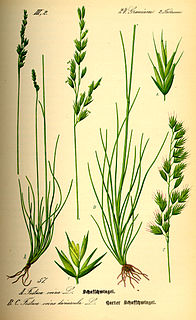
Festuca ovina, sheep's fescue or sheep fescue, is a species of grass. It is sometimes confused with hard fescue.
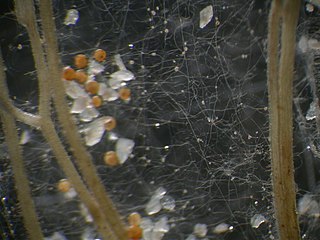
Glomeromycota are one of eight currently recognized divisions within the kingdom Fungi, with approximately 230 described species. Members of the Glomeromycota form arbuscular mycorrhizas (AMs) with the thalli of bryophytes and the roots of vascular land plants. Not all species have been shown to form AMs, and one, Geosiphon pyriformis, is known not to do so. Instead, it forms an endocytobiotic association with Nostoc cyanobacteria. The majority of evidence shows that the Glomeromycota are dependent on land plants for carbon and energy, but there is recent circumstantial evidence that some species may be able to lead an independent existence. The arbuscular mycorrhizal species are terrestrial and widely distributed in soils worldwide where they form symbioses with the roots of the majority of plant species (>80%). They can also be found in wetlands, including salt-marshes, and associated with epiphytic plants.
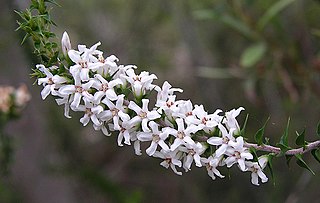
The ericoid mycorrhiza is a mutualistic relationship formed between members of the plant family Ericaceae and several lineages of mycorrhizal fungi. This symbiosis represents an important adaptation to acidic and nutrient poor soils that species in the Ericaceae typically inhabit, including boreal forests, bogs, and heathlands. Molecular clock estimates suggest that the symbiosis originated approximately 140 million years ago.
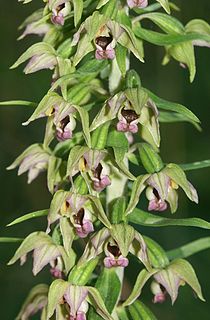
Epipactis helleborine, the broad-leaved helleborine, is a terrestrial species of orchid with a broad distribution. It is a long lived herb which varies morphologically with ability to self-pollinate.
Microbial inoculants also known as soil inoculants or bioinoculants are agricultural amendments that use beneficial rhizosphericic or endophytic microbes to promote plant health. Many of the microbes involved form symbiotic relationships with the target crops where both parties benefit (mutualism). While microbial inoculants are applied to improve plant nutrition, they can also be used to promote plant growth by stimulating plant hormone production.
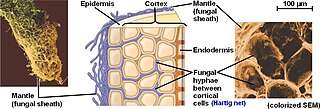
Hartig net is a network of inward-growing hyphae, that extends into the root, penetrating between the epidermis and cortex of ectomycorrhizal plants. This network is a site of nutrient exchange between the fungus and the host plant. The Hartig net is one of the three components required for ectomycorrhizal roots to form as part of ectomycorrhizal symbiosis with the host tree or plant.
Gopi K. Podila was an Indian–American biologist who served as a professor at the University of Alabama in Huntsville. He was one of three faculty members killed in a shooting at the university on February 12, 2010. Podila was chairperson of the university's department of biological sciences, with a particular interest in the ecology of Populus and their mycorrhizal symbionts.
Nitrogen nutrition in the arbuscular mycorrhizal system refers to...

Mycorrhizal networks are underground hyphal networks created by mycorrhizal fungi that connect individual plants together and transfer water, carbon, nitrogen, and other nutrients and minerals.

An ectomycorrhiza is a form of symbiotic relationship that occurs between a fungal symbiont, or mycobiont, and the roots of various plant species. The mycobiont is often from the phyla Basidiomycota and Ascomycota, and more rarely from the Zygomycota. Ectomycorrhizas form on the roots of around 2% of plant species, usually woody plants, including species from the birch, dipterocarp, myrtle, beech, willow, pine and rose families. Research on ectomycorrhizas is increasingly important in areas such as ecosystem management and restoration, forestry and agriculture.

Rhizophagus is a genus of arbuscular mycorrhizal (AM) fungi that form symbiotic relationships (mycorrhizas) with plant roots. The genome of Rhizophagus irregularis was recently sequenced.

The Arbutoideae are a subfamily in the flowering plant family Ericaceae. Phylogenetic analysis supported all genera of the subfamily as monophyletic, except Arbutus. Moreover, it was suggested that the non-sister relationship between Mediterranean and North American species may be explained by a once widespread distribution in the Northern hemisphere before the Neogene.

Funneliformis is a genus of fungi in the family Glomeraceae. All species are arbuscular mycorrhizal (AM) fungi that form symbiotic relationships (mycorrhizaa) with plant roots. The genus was circumscribed in 2010 by Arthur Schüßler and Christopher Walker, with Funneliformis mosseae as the type species. The generic name refers to the funnel-shaped spore base present in several species.
Sarah Elizabeth Smith was a British-born Australian mycologist specialising in mycorrhiza. The Australian Academy of Science described her as "a world authority on the mycorrhizal symbiosis between plants and fungi". She was an adjunct and emeritus professor at the University of Adelaide, in the School of Agriculture, Food and Wine.
Orchid mycorrhizae are symbiotic relationships between the roots of plants of the family Orchidaceae and a variety of fungi. Nearly all orchids are myco-heterotrophic at some point in their life cycle. Orchid mycorrhizae are critically important during orchid germination, as an orchid seed has virtually no energy reserve and obtains its carbon from the fungal symbiont.
Mycorrhizae and climate change refers to the effects of climate change on mycorrhizae, a fungus which forms an endosymbiotic relationship between with a vascular host plant by colonizing its roots, and the effects brought on by climate change. Climate change is any lasting effect in weather or temperature. It is important to note that a good indicator of climate change is global warming, though the two are not analogous. However, temperature plays a very important role in all ecosystems on Earth, especially those with high counts of mycorrhiza in soil biota.
Rhizopogon amylopogon is a sub-genus of Rhizopogon containing seven species.

Celtis caucasica, the Caucasian hackberry or Caucasian nettle tree, is a species of flowering plant in the family Cannabaceae. It is native to the Caucasus region, Central Asia, and on to the western Himalaya. Hardy to USDA zone 5b, it tolerates poor soils, drought, and nearby paving, and can be used as street tree. It is a nitrogen-fixer, in symbiosis with the mycorrhizal fungi Funneliformis mosseae and Rhizophagus intraradices.













